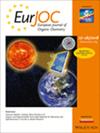流动化学中铜圈作为高效、廉价的四氮唑合成反应器
IF 2.7
3区 化学
Q2 CHEMISTRY, ORGANIC
引用次数: 0
摘要
沙坦类药物是治疗高血压的一类重要药物。它们的一个共同特征是在苯基-苯基键的邻位上有一个四唑环的联苯部分。这种四唑通常是由各自的腈通过[3 + 2]叠氮化物-腈环加成合成的。然而,在高温下长时间使用大量叠氮化物本身就令人担忧,因为如果不彻底制定和执行安全规程,就可能发生严重事故。因此,从安全角度来看,在连续流动中实施这些程序是有益的。本文介绍了一种以铜线圈为反应器和催化剂,从相应的腈中制备四唑的方法。研究并优化了反应参数,使转化率最大化。对不同环取代基的多种苯并腈进行了中高收率的转化,并对铜的浸出进行了分析,结果表明浸出的铜足以催化该反应。更有趣的是,该方法已被应用于获得沙坦制造中使用的关键中间体中的四唑环,这是一种高度立体受阻的化合物。本文章由计算机程序翻译,如有差异,请以英文原文为准。
Copper Coils as Efficient and Inexpensive Reactors for the Synthesis of Tetrazoles in Flow Chemistry
Sartans are an important family of drugs used to treat hypertension. A common characteristic of most of them is a biphenyl moiety with a tetrazole ring in the ortho position of the phenyl–phenyl bond. This tetrazole is typically synthesized from the respective nitriles through a [3 + 2] azide‐nitrile cycloaddition. However, the use of large amounts of azides at high temperatures for extended periods of time is inherently concerning, as serious accidents can occur if safety protocols are not thoroughly developed and implemented. The implementation of these procedures in continuous flow would therefore be beneficial from the safety perspective. In this article, a method is presented for the preparation of tetrazoles from the respective nitriles employing a copper coil as reactor and catalyst. The reaction parameters have been studied and optimized to maximize conversion. A variety of benzonitriles with different ring substituents have been transformed in moderate to good yields and copper leaching has been analyzed, showing that the copper leached is enough to catalyze this reaction. More interestingly, the method has been applied to obtain the tetrazole ring present in a key intermediate used in sartan manufacturing, a highly sterically hindered compound.
求助全文
通过发布文献求助,成功后即可免费获取论文全文。
去求助
来源期刊
CiteScore
5.40
自引率
3.60%
发文量
752
审稿时长
1 months
期刊介绍:
The European Journal of Organic Chemistry (2019 ISI Impact Factor 2.889) publishes Full Papers, Communications, and Minireviews from the entire spectrum of synthetic organic, bioorganic and physical-organic chemistry. It is published on behalf of Chemistry Europe, an association of 16 European chemical societies.
The following journals have been merged to form two leading journals, the European Journal of Organic Chemistry and the European Journal of Inorganic Chemistry:
Liebigs Annalen
Bulletin des Sociétés Chimiques Belges
Bulletin de la Société Chimique de France
Gazzetta Chimica Italiana
Recueil des Travaux Chimiques des Pays-Bas
Anales de Química
Chimika Chronika
Revista Portuguesa de Química
ACH—Models in Chemistry
Polish Journal of Chemistry.

 求助内容:
求助内容: 应助结果提醒方式:
应助结果提醒方式:


